Quality Assessment of PROBA-V Surface Albedo V1 for the Continuity of the Copernicus Climate Change Service
Abstract
1. Introduction
- To evaluate the product completeness and spatio-temporal consistency of C3S PROBA-V SA v1.0 products over global conditions compared to SPOT/VGT SA v1.0 (and MCD43A3 C6 for benchmarking) to verify the continuity of the C3S time series;
- To assess the precision of C3S PROBA-V SA v1.0 and to intercompare it with reference satellite products (C3S SPOT/VGT SA v1.0 and MCD43A3 C6);
- To assess the accuracy and the associated uncertainties of the products via direct validation with ground measurements; and
- To assess the compliance of the product with regards to climate user requirements.
2. Remote Sensing Surface Albedo Products
2.1. Evaluated Dataset: C3S SA v1.0 Based on PROBA-V Data
2.2. C3S SA v1.0 Based on SPOT/VGT Data
2.3. NASA MCD43 C6 Based on MODIS Data
3. Ground Dataset
3.1. Ground-Based Observations for Validation (GBOV) Database
3.2. Analysis of the Spatial Representativeness of Tower Measurements
4. Quality Assessment Methodology
4.1. Uncertainty Requirements
4.2. Validation Methods
4.2.1. Validation Metrics
4.2.2. Satellite Product Intercomparison
4.2.3. Ground-Based Validation
5. Results
5.1. Satellite Product Intercomparison
5.1.1. Product Completeness
5.1.2. Temporal Consistency
5.1.3. Spatio-Temporal Consistency
- PROBA-V SA v1.0 versus SPOT/VGT SA v1.0 (overlap period)
- PROBA-V SA v1.0 versus MCD43A3 C6 (2014 year)
- Compliance with user requirements
5.1.4. Intra-Annual Precision
5.1.5. Inter-Annual Precision
5.2. Ground-Based Direct Validation
6. Discussion
7. Conclusions
- The good spatio-temporal consistency of C3S PROBA-V and SPOT/VGT SA v1.0 products assures the continuity of the CDRs in terms of the uncertainty between products. However, C3S PROBA-V SA v1.0 (and MCD32A3 C6) provides low numbers of valid retrievals compared to C3S SPOT/VGT SA v1.0.
- C3S PROBA-V SA v1.0 shows similar inter-annual precision (~1%) to MCD43A3 C6, improving the results of SPOT/VGT SA v1.0 (2–3%), since they provide some temporal instability over desert calibration targets. Both C3S products provide lower intra-annual precision than MCD43A3 C6, mainly in the NIR domain where some temporal noise was found.
- The accuracy of the C3S PROBA-V SA v1.0 best quality retrievals with respect to the ground data over a five-year period (2014–2018) showed systematic positive overestimation, which was mainly observed for the lowest albedo ranges (SA < 0.2) over forest sites. Similar uncertainty (RMSD) was found for MCD43A3 C6 products using the same sampling, showing the opposite sign for the mean bias.
- Few current satellite EO albedo products comply with the GCOS, C3S and WMO uncertainty requirements.
Author Contributions
Funding
Acknowledgments
Conflicts of Interest
Abbreviations
| AL-DH | Directional-Hemispherical ALbedos |
| AL-BH | Bi-Hemispherical Albedos |
| ATBD | Algorithm Theoretical Basis Document |
| AVHRR | Advanced Very High Resolution Radiometer |
| BB | total shortwave |
| BRDF | Bidirectional Reflectance Distribution Function |
| BSA | Black-Sky Albedo |
| BSRN | Baseline Surface Radiation Network |
| CDR | Climate Data Records |
| CDS | Climate Data Store of C3S |
| CEOS | Committee on Earth Observing Satellites |
| CGLS | Copernicus Global Land Service |
| C3S | Copernicus Climate Change Service |
| C6 | Collection 6 of MODIS products |
| ECV | Essential Climate Variables |
| EO | Earth Observation |
| EQC | Evaluation and Quality Control |
| EUMETSAT | European Organization for the Exploitation of Meteorological Satellites |
| FLUXNET | FLUXes NETwork (network of regional networks) |
| GBOV | Ground-Based Observations for Validation |
| CGOS | Global Climate Observing System |
| GLASS | Global Land Surface Satellite |
| GSD | Ground Sampling Distance |
| JCGM | Joint Committee for Guides in Metrology |
| KPI | Key Performance Indicator |
| LANDVAL | LAND VALidation network |
| LSA SAF | Satellite Application Facility for Land Surface Analysis |
| LPV | Land Product Validation sub-group |
| MAR | Major Axis Regression |
| MCD43 | TERRA+AQUA MODIS BRDF/Albedo/NBAR Product |
| MetOp | Polar-orbiting Meteorological satellites |
| MIR | Mid InfraRed |
| MODIS | MODerate resolution Imaging Spectroradiometer |
| MSG | Meteosat Second Generation |
| N | Number of samples |
| NASA | National Aeronautics and Space Agency |
| NEON | National Ecological Observatory Network |
| NIR (or NI) | Near-Infrared |
| NOAA | National Oceanic and Atmospheric Administration |
| OLCI | Ocean and Land Colour Instrument |
| OLS | Ordinary Least Squares |
| LP | Land Products |
| PROBA-V | Project for Onboard Autonomy satellite, the V standing for vegetation |
| PUGS | Product User Guide and Specification document |
| QFLAG | Quality FLAG |
| R | Correlation coefficient |
| RM | Reference Measurements |
| RMSD | Root Mean Square Deviation |
| RTLSR | Ross Thick kernel and Li Sparse-Reciprocal kernels |
| SA | Surface Albedo |
| SEVIRI | Spinning Enhanced Visible and Infrared Imager |
| SLSTR | Sea and Land Surface Temperature Radiometer |
| SPOT | Satellites for the Observation of the Earth |
| SURFRAD | Surface Radiation budget |
| SWIR | Short-Wave InfraRed |
| TOA | Top-Of-Atmosphere |
| TOC | Top-Of-Canopy |
| VGT | VeGeTation sensor |
| VI | Visible domain |
| VNIR | Visible and Near-InfRared |
| WGCV | Working Group on Calibration and Validation |
| WMO | World Meteorological Organization |
| WSA | White-Sky Albedo |
Appendix A. Ground-Based Direct Validation per Biome Type
- C3S PROBA-V SA v1.0
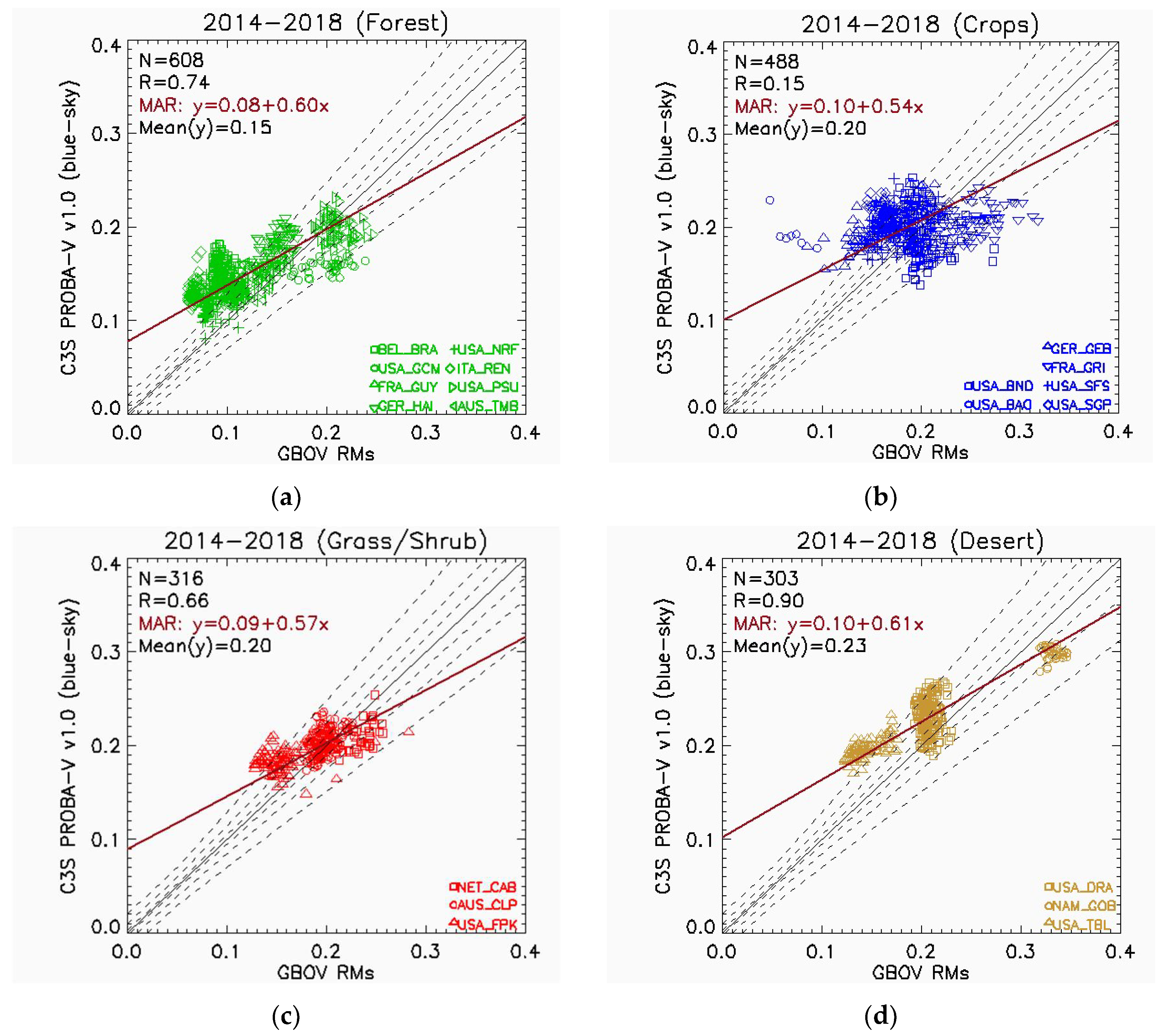
- MCD43A3 C6
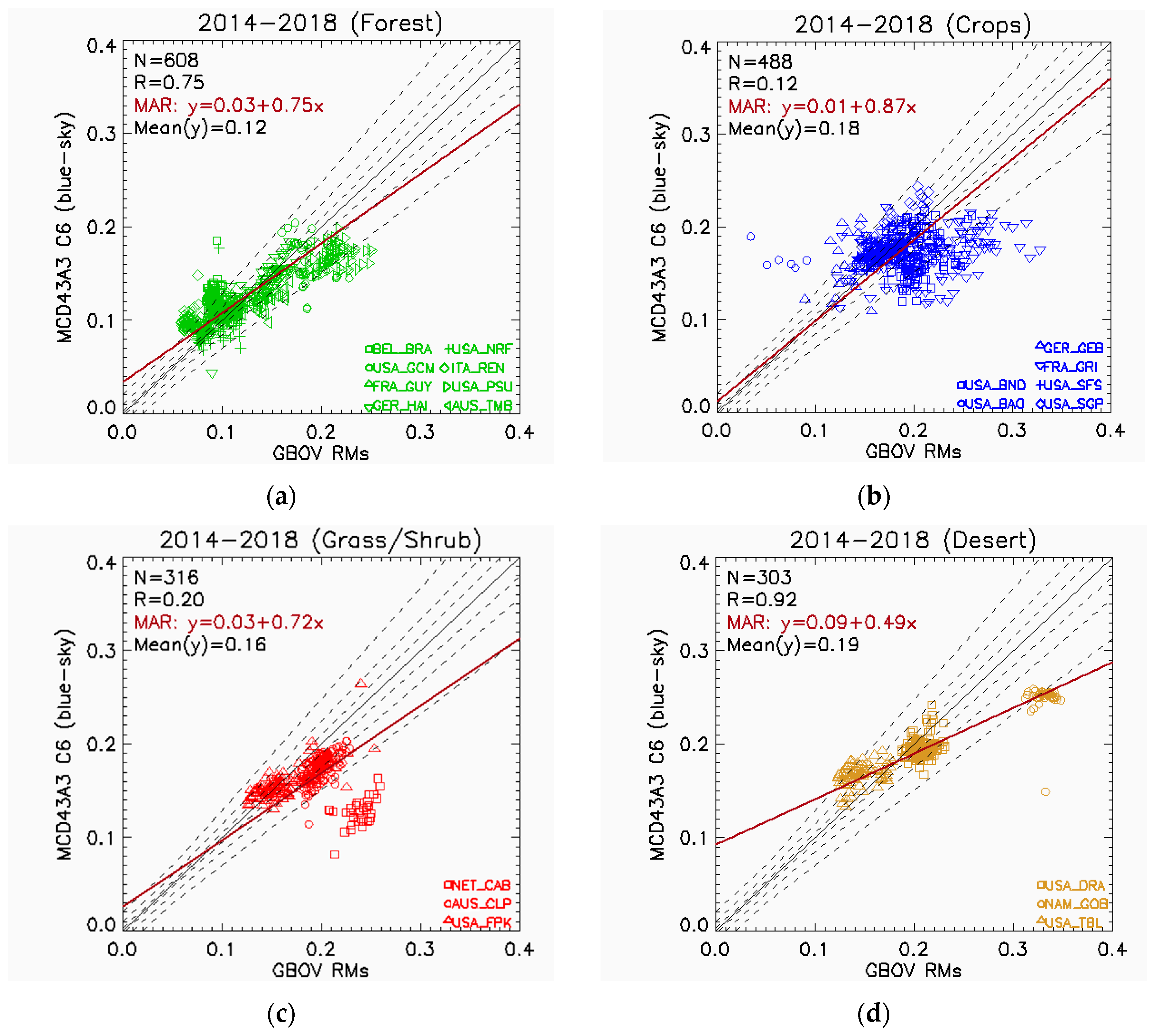
Appendix B. Temporal Realism of Blue-Sky Albedos over Gbov Sites
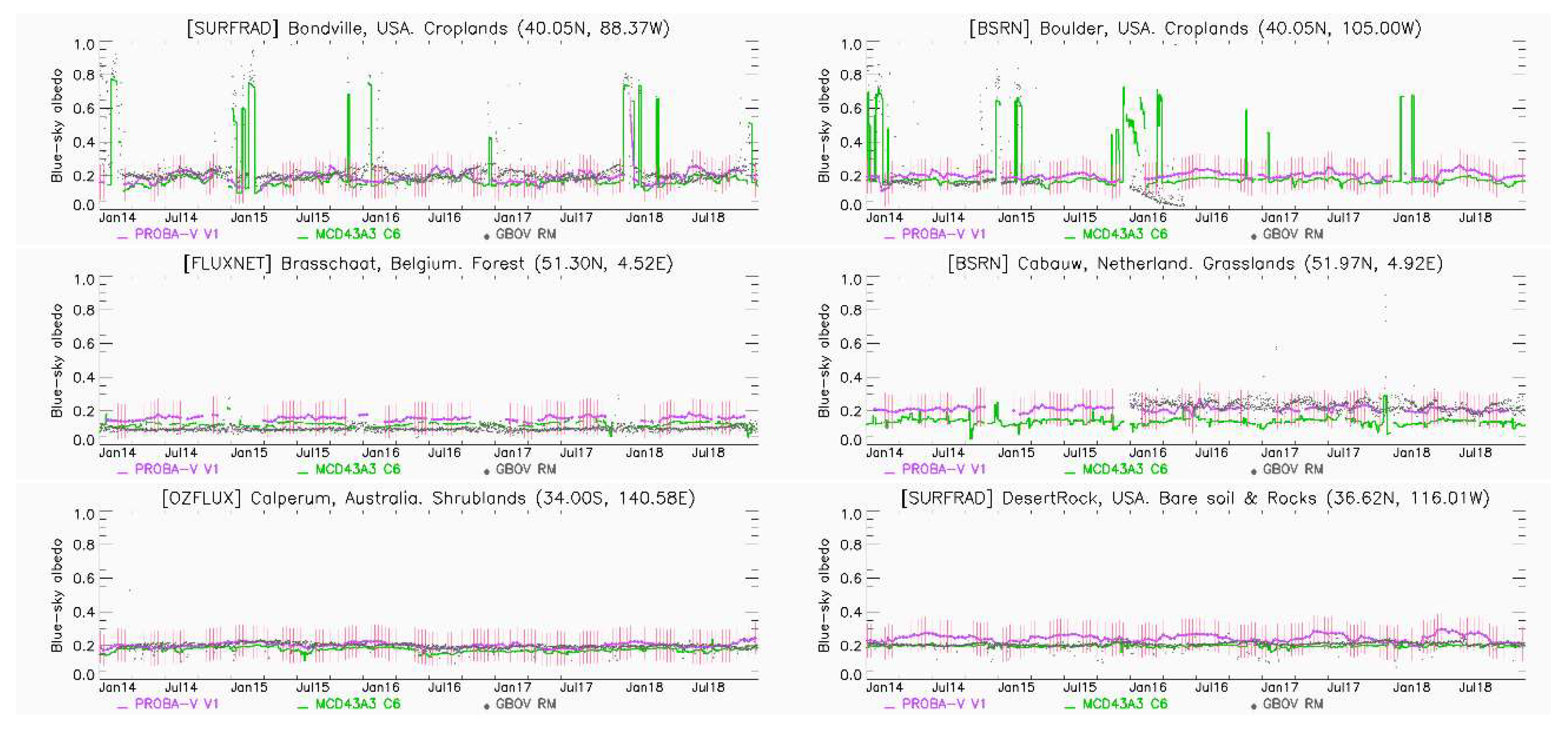
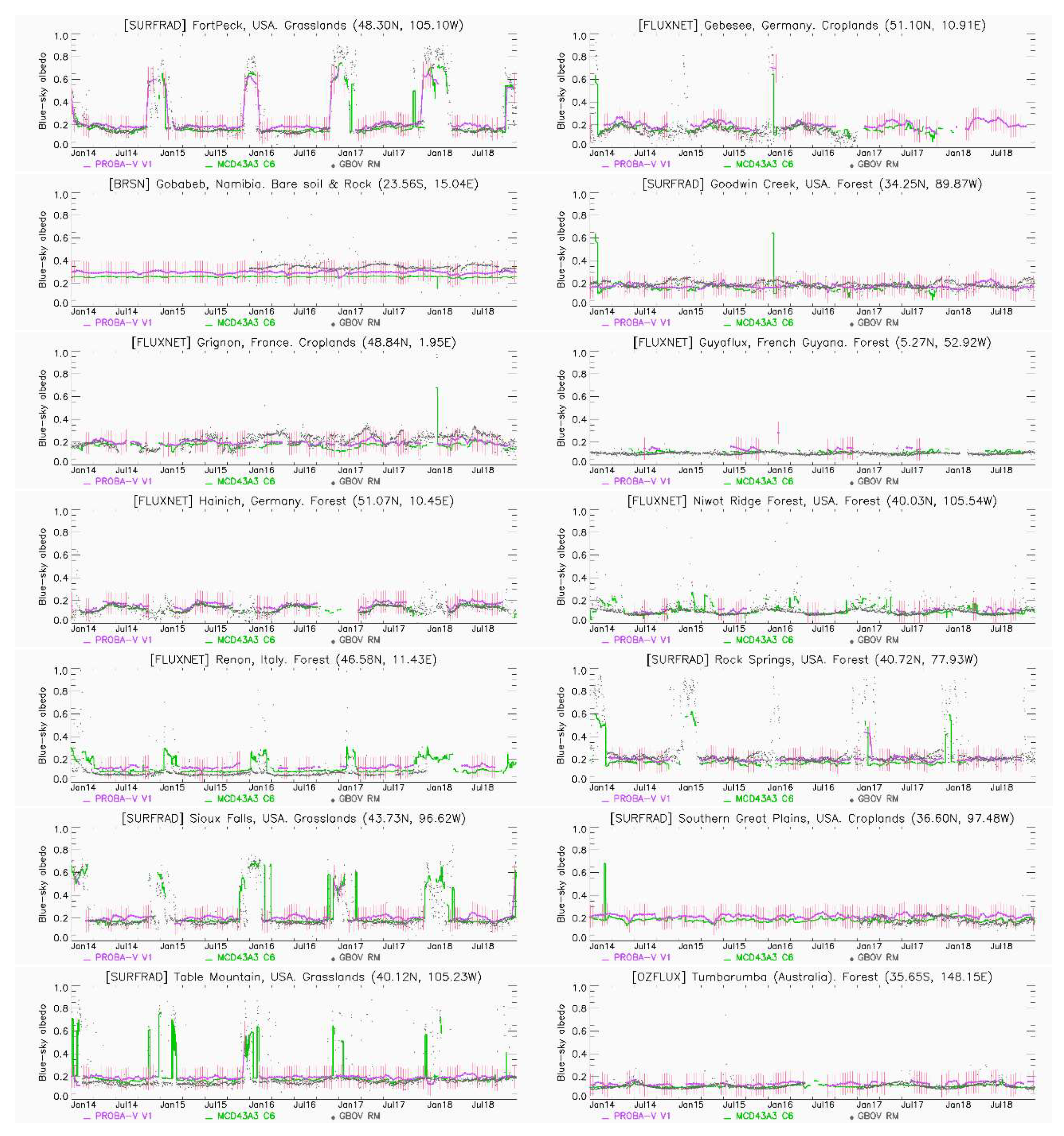
References
- Implementation Plan for the Global Observing System for Climate in Support of the United Nations Framework Convention on Climate Change (UNFCCC). GCOS-No 92. 2004. Available online: https://library.wmo.int/index.php?lvl=notice_display&id=6678#.Xowv2-oza5t (accessed on 7 April 2020).
- Copernicus Climate Change Service (C3S). Available online: https://climate.copernicus.eu/ (accessed on 7 April 2020).
- Wolters, E.; Dierckx, W.; Iordache, M.-D.; Swinnen, E. PROBA-V Products User Manual Document v3.01. Available online: http://proba-v.vgt.vito.be/sites/proba-v.vgt.vito.be/files/products_user_manual.pdf (accessed on 7 April 2020).
- Trigo, I.F.; Dacamara, C.C.; Viterbo, P.; Roujean, J.-L.; Olesen, F.; Barroso, C.; Camacho-de-Coca, F.; Carrer, D.; Freitas, S.C.; García-Haro, J.; et al. The Satellite Application Facility for Land Surface Analysis. Int. J. Remote Sens. 2011, 32, 2725–2744. [Google Scholar] [CrossRef]
- Land Surface Analysis (LSA-SAF) of EUMETSAT. Available online: https://landsaf.ipma.pt/en/ (accessed on 8 April 2020).
- Geiger, B.; Carrer, D.; Franchistéguy, L.; Roujean, J.L.; Meurey, C. Land surface albedo derived on a daily basis from meteosat second generation observations. IEEE Trans. Geosci. Remote Sens. 2008, 46, 3841–3856. [Google Scholar] [CrossRef]
- Carrer, D.; Roujean, J.L.; Meurey, C. Comparing operational MSG/SEVIRI Land Surface albedo products from Land SAF with ground measurements and MODIS. IEEE Trans. Geosci. Remote Sens. 2010, 48, 1714–1728. [Google Scholar] [CrossRef]
- Carrer, D.; Roujean, J.-L.; Hautecoeur, O.; Elias, T. Daily estimates of aerosol optical thickness over land surface based on a directional and temporal analysis of SEVIRI MSG visible observations. J. Geophys. Res. 2010, 115, D10208. [Google Scholar] [CrossRef]
- Carrer, D.; Moparthy, S.; Lellouch, G.; Ceamanos, X.; Pinault, F.; Freitas, S.C.; Trigo, I.F. Land surface albedo derived on a ten daily basis from Meteosat Second Generation Observations: The NRT and climate data record collections from the EUMETSAT LSA SAF. Remote Sens. 2018, 10, 1262. [Google Scholar] [CrossRef]
- Copernicus Global Land Service (CGLS) Portal. Available online: https://land.copernicus.eu/global/index.html (accessed on 8 April 2020).
- Climate Data Store of Copernicus Climate Change Service. Available online: https://cds.climate.copernicus.eu/#!/home (accessed on 10 May 2020).
- Nightingale, J.; Mittaz, J.P.D.; Douglas, S.; Dee, D.; Ryder, J.; Taylor, M.; Old, C.; Dieval, C.; Fouron, C.; Duveau, G.; et al. Ten Priority Science Gaps in Assessing Climate Data Record Quality. Remote Sens. 2019, 11, 986. [Google Scholar] [CrossRef]
- Justice, C.; Belward, A.; Morisette, J.; Lewis, P.; Privette, J.; Baret, F. Developments in the’validation’of satellite sensor products for the study of the land surface. Int. J. Remote Sens. 2000, 21, 3383–3390. [Google Scholar] [CrossRef]
- Zeng, Y.; Su, Z.; Calvet, J.C.; Manninen, T.; Swinnen, E.; Schulz, J.; Roebeling, R.; Poli, P.; Tan, D.; Riihelä, A.; et al. Analysis of current validation practices in Europe for space-based climate data records of essential climate variables. Int. J. Appl. Earth Obs. Geoinf. 2015, 42, 150–161. [Google Scholar] [CrossRef]
- Liang, S.; Fang, H.; Chen, M.; Shuey, C.J.; Walthall, C.; Daughtry, C.; Morisette, J.; Schaaf, C.; Strahler, A. Validating MODIS land surface reflectance and albedo products: Methods and preliminary results. Remote Sens. Environ. 2002, 83, 149–162. [Google Scholar] [CrossRef]
- Cescatti, A.; Marcolla, B.; Santhana Vannan, S.K.; Pan, J.Y.; Román, M.O.; Yang, X.; Ciais, P.; Cook, R.B.; Law, B.E.; Matteucci, G.; et al. Intercomparison of MODIS albedo retrievals and in situ measurements across the global FLUXNET network. Remote Sens. Environ. 2012, 121, 323–334. [Google Scholar] [CrossRef]
- Liu, Q.; Wang, L.; Qu, Y.; Liu, N.; Liu, S.; Tang, H.; Liang, S. Preliminary evaluation of the long-term GLASS albedo product. Int. J. Digit. Earth 2013, 6, 69–95. [Google Scholar] [CrossRef]
- Liu, Y.; Wang, Z.; Sun, Q.; Erb, A.M.; Li, Z.; Schaaf, C.B.; Zhang, X.; Román, M.O.; Scott, R.L.; Zhang, Q.; et al. Evaluation of the VIIRS BRDF, Albedo and NBAR products suite and an assessment of continuity with the long term MODIS record. Remote Sens. Environ. 2017, 201, 256–274. [Google Scholar] [CrossRef]
- Shuai, Y.; Schaaf, C.B.; Strahler, A.H.; Liu, J.; Jiao, Z. Quality assessment of BRDF/albedo retrievals in MODIS operational system. Geophys. Res. Lett. 2008, 35, 1–5. [Google Scholar] [CrossRef]
- LPV (Land Product Validation). Subgroup CEOS Validation Hierarchy 2019. Available online: https://lpvs.gsfc.nasa.gov/ (accessed on 12 April 2020).
- Wang, Z.; Schaaf, C.; Lattanzio, A.; Carrer, D.; Grant, I.; Roman, M.; Camacho, F.; Yang, Y.; Sánchez-Zapero, J. Global Surface Albedo Product Validation Best Practices Protocol. Version 1.0. In Best Practice for Satellite Derived Land Product Validation (p. 45): Land Product Validation Subgroup (WGCV/CEOS); Wang, Z., Nickeson, J., Román, M., Eds.; Available online: https://lpvs.gsfc.nasa.gov/PDF/CEOS_ALBEDO_Protocol_20190307_v1.pdf (accessed on 1 April 2020). [CrossRef]
- Taberner, M.; Pinty, B.; Govaerts, Y.; Liang, S.; Verstraete, M.M.; Gobron, N.; Widlowski, J.L. Comparison of MISR and MODIS land surface albedos: Methodology. J. Geophys. Res. Atmos. 2010, 115, 1–13. [Google Scholar] [CrossRef]
- Qu, Y.; Liu, Q.; Liang, S.; Wang, L.; Liu, N.; Liu, S. Direct-estimation algorithm for mapping daily land-surface broadband albedo from modis data. IEEE Trans. Geosci. Remote Sens. 2014, 52, 907–919. [Google Scholar] [CrossRef]
- Sütterlin, M.; Schaaf, C.B.; Stöckli, R.; Sun, Q.; Hüsler, F.; Neuhaus, C.; Wunderle, S. Albedo and reflectance anisotropy retrieval from AVHRR operated onboard NOAA and MetOp satellites: Algorithm performance and accuracy assessment for Europe. Remote Sens. Environ. 2015, 168, 163–176. [Google Scholar] [CrossRef]
- Fell, F.; Bennartz, R.; Loew, A. Validation of the EUMETSAT Geostationary Surface Albedo Climate Data Record -2- (ALBEDOVAL-2). Available online: https://www.eumetsat.int/website/home/Data/TechnicalDocuments/index.html (accessed on 12 April 2020).
- Camacho, F.; Sánchez-Zapero, J. Quality Assessment Report SPOT/VGT Suface Albedo V1 (I1.10). Gio Global Land Component - Lot I ”Operation of the Global Land Component” Framework Service Contract N° 388533 (JRC). Available online: https://land.copernicus.eu/global/sites/cgls.vito.be/files/products/GIOGL1_VR_SAV1_I1.10.pdf (accessed on 25 March 2020).
- Sánchez-Zapero, J.; de la Madrid, L.; Camacho, F. Validation Report of Surface Albedo (SA) from PROBA-V Collection 1km Version 1.5 (I2.21). Copernicus Global Land Operations CGLOPS-1 (Framework Service Contract N° 199494 - JRC). Available online: https://land.copernicus.eu/global/sites/cgls.vito.be/files/products/CGLOPS1_VR_SA1km-PROBAV-V1.5_I2.21.pdf (accessed on 9 April 2020).
- Sánchez-Zapero, J.; de la Madrid, L.; Camacho, F. Quality Assessment Report Normalized TOC-r from PROBA-V Collection 1 km Version 1.5 (I2.21). Copernicus Global Land Operations “Vegetation and Energy” ”CGLOPS-1” Framework Service Contract N° 199494 (JRC). Available online: https://land.copernicus.eu/global/sites/cgls.vito.be/files/products/CGLOPS1_QAR_TOCR1km-PROBAV-V1.5_I2.21.pdf (accessed on 11 August 2020).
- Mayr, S.; Kuenzer, C.; Gessner, U.; Klein, I.; Rutzinger, M. Validation of Earth Observation Time-Series: A Review for Large-Area and Temporally Dense Land Surface Products. Remote Sens. 2019, 11, 2616. [Google Scholar] [CrossRef]
- Lewis, P.; Barnsley, M. Influence of the sky radiance distribution on various formulations of the earth surface albedo. In Proceedings of the 6th International Symposium on Physical Measurements and Signatures in Remote Sensing (ISPRS), Val d’Isere, France, 17–21 January 1994; pp. 707–715. [Google Scholar]
- Román, M.O.; Schaaf, C.B.; Woodcock, C.E.; Strahler, A.H.; Yang, X.; Braswell, R.H.; Curtis, P.S.; Davis, K.J.; Dragoni, D.; Goulden, M.L.; et al. The MODIS (Collection V005) BRDF/albedo product: Assessment of spatial representativeness over forested landscapes. Remote Sens. Environ. 2009, 113, 2476–2498. [Google Scholar] [CrossRef]
- Román, M.O.; Schaaf, C.B.; Lewis, P.; Gao, F.; Anderson, G.P.; Privette, J.L.; Strahler, A.H.; Woodcock, C.E.; Barnsley, M. Assessing the coupling between surface albedo derived from MODIS and the fraction of diffuse skylight over spatially-characterized landscapes. Remote Sens. Environ. 2010, 114, 738–760. [Google Scholar] [CrossRef]
- Wang, Z.; Schaaf, C.B.; Chopping, M.J.; Strahler, A.H.; Wang, J.; Román, M.O.; Rocha, A.V.; Woodcock, C.E.; Shuai, Y. Evaluation of Moderate-resolution Imaging Spectroradiometer (MODIS) snow albedo product (MCD43A) over tundra. Remote Sens. Environ. 2012, 117, 264–280. [Google Scholar] [CrossRef]
- Wang, Z.; Schaaf, C.B.; Strahler, A.H.; Chopping, M.J.; Román, M.O.; Shuai, Y.; Woodcock, C.E.; Hollinger, D.Y.; Fitzjarrald, D.R. Evaluation of MODIS albedo product (MCD43A) over grassland, agriculture and forest surface types during dormant and snow-covered periods. Remote Sens. Environ. 2014, 140, 60–77. [Google Scholar] [CrossRef]
- Carrer, D.; Ceamanos, X.; Pinault, F.; Benhadj, I.; Toté, C. Algorithm Theoretical Basis Document (ATBD) of PROBA-V CDR and ICDR Surface Albedo v1.0 (Official Reference Number Service Contract: 2018/C3S_312b_Lot5_VITO/SC1). Available online: https://cds.climate.copernicus.eu/cdsapp#!/dataset/satellite-albedo?tab=doc (accessed on 9 April 2020).
- Carrer, D.; Pinault, F.; Ramon, D.; Benhadj, I.; Swinnen, E. Algorithm Theoretical Basis Document (ATBD) of CDR SPOT/VGT Surface Albedo v1.0 (Official Reference Number Service Contract: 2018/C3S_312b_Lot5_VITO/SC1). Available online: https://cds.climate.copernicus.eu/cdsapp#!/dataset/satellite-albedo?tab=doc (accessed on 9 April 2020).
- Schaaf, C.B.; Gao, F.; Strahler, A.H.; Lucht, W.; Li, X.; Tsang, T.; Strugnell, N.C.; Zhang, X.; Jin, Y.; Muller, J.P.; et al. First operational BRDF, albedo nadir reflectance products from MODIS. Remote Sens. Environ. 2002, 83, 135–148. [Google Scholar] [CrossRef]
- Francois, M.; Santandrea, S.; Mellab, K.; Vrancken, D.; Versluys, J. The PROBA-V mission: The space segment. Int. J. Remote Sens. 2014, 35, 2548–2564. [Google Scholar] [CrossRef]
- Dierckx, W.; Sterckx, S.; Benhadj, I.; Livens, S.; Duhoux, G.; Van Achteren, T.; Francois, M.; Mellab, K.; Saint, G. PROBA-V mission for global vegetation monitoring: Standard products and image quality. Int. J. Remote Sens. 2014, 35, 2589–2614. [Google Scholar] [CrossRef]
- PROBA-V Products Data Access. Available online: http://proba-v.vgt.vito.be/en/product-types (accessed on 8 April 2020).
- Carrer, D.; Benhadj, I. Product User Guide and Specification (PUGS) of PROBA-V CDR and ICDR Surface Albedo v1.0 (Official Reference Number Service Contract: 2018/C3S_312b_Lot5_VITO/SC1). Available online: https://cds.climate.copernicus.eu/cdsapp#!/dataset/satellite-albedo?tab=doc (accessed on 9 April 2020).
- Roujean, J.-L.; Leroy, M.; Deschamps, P.-Y. A bidirectional reflectance model of the Earth’s surface for the correction of remote sensing data. J. Geophys. Res. 1992, 97, 20455–20468. [Google Scholar] [CrossRef]
- Carrer, D.; Smets, B.; Ceamanos, X.; Roujean, J.-L. SPOT/VEGETATION and PROBA-V Surface Albedo Products—1 Km Version 1; Algorithm Theoretical Basis Document (ATBD), Issue 2.11. Copernicus Global Land Operations CGLOPS-1 (Framework Service Contract N° 199494-JRC). Available online: https://land.copernicus.eu/global/sites/cgls.vito.be/files/products/CGLOPS1_ATBD_SA1km-V1_I2.11.pdf (accessed on 10 May 2020).
- Toté, C.; Swinnen, E.; Sterckx, S.; Clarijs, D.; Quang, C.; Maes, R. Evaluation of the SPOT/VEGETATION Collection 3 reprocessed dataset: Surface reflectances and NDVI. Remote Sens. Environ. 2017, 201, 219–233. [Google Scholar] [CrossRef]
- Lucht, W.; Schaaf, C.B.; Strahler, A.H. An algorithm for the retrieval of albedo from space using semiempirical BRDF models. IEEE Trans. Geosci. Remote Sens. 2000, 38, 977–998. [Google Scholar] [CrossRef]
- Sanchez-Zapero, J. Product Quality Assessment Report (PQAR) of CDR SPOT/VGT-Based Surface Albedo v1.0 (Official Reference Number Service Contract: 2018/C3S_312b_Lot5_VITO/SC1). Available online: https://cds.climate.copernicus.eu/cdsapp#!/dataset/satellite-albedo?tab=doc (accessed on 9 April 2020).
- Schaaf, C.; Wang, Z. MCD43A3 MODIS/Terra+Aqua BRDF/Albedo Daily L3 Global-500m V006 [Data set]. NASA EOSDIS Land Processes DAAC. 2015. Available online: https://doi.org/10.5067/MODIS/MCD43A3.006 (accessed on 10 April 2020).
- Lucht, W.; Lewis, P. Theoretical noise sensitivity of BRDF and albedo retrieval from the EOS-MODIS and MISR sensors with respect to angular sampling. Int. J. Remote Sens. 2000, 21, 81–98. [Google Scholar] [CrossRef]
- Sun, Q.; Wang, Z.; Li, Z.; Erb, A.; Schaaf, C.B. Evaluation of the global MODIS 30 arc-second spatially and temporally complete snow-free land surface albedo and reflectance anisotropy dataset. Int. J. Appl. Earth Obs. Geoinf. 2017, 58, 36–49. [Google Scholar] [CrossRef]
- Liang, S.; Strahler, A.H.; Walthall, C. Retrieval of Land Surface Albedo from Satellite Observations: A Simulation Study. J. Appl. Meteorol. 1999, 38, 712–725. [Google Scholar] [CrossRef]
- Wang, Z.; Schaaf, C.B.; Sun, Q.; Shuai, Y.; Román, M.O. Capturing rapid land surface dynamics with Collection V006 MODIS BRDF/NBAR/Albedo (MCD43) products. Remote Sens. Environ. 2018, 207, 50–64. [Google Scholar] [CrossRef]
- Roujean, J.L.; Leon-Tavares, J.; Smets, B.; Claes, P.; Camacho De Coca, F.; Sanchez-Zapero, J. Surface albedo and toc-r 300 m products from PROBA-V instrument in the framework of Copernicus Global Land Service. Remote Sens. Environ. 2018, 215, 57–73. [Google Scholar] [CrossRef]
- Ground-Based Observations for Validation (GBOV) of Copernicus Global Land Products Site. Available online: https://land.copernicus.eu/global/gbov (accessed on 1 April 2020).
- Song, R.; Muller, J.-P.; Kharbouche, S.; Woodgate, W. Intercomparison of Surface Albedo Retrievals from MISR, MODIS, CGLS Using Tower and Upscaled Tower Measurements. Remote Sens. 2019, 11, 644. [Google Scholar] [CrossRef]
- Kharbouche, S.; Song, R.; Muller, J.-P. Algorithm Theoretical Basis Document of Energy products: RM1 (short wave radiation), LP1 (Top Of Canopy Reflectance), LP2 (Albedo). Ground-Based Observations for Validation (GBOV) of CGLS Products (Framework Contract reference: 932059-JRC). Available online: https://gbov.acri.fr/public/docs/products/2019-11/GBOV-ATBD-RM1-LP1-LP2_v1.3-Energy.pdf (accessed on 10 April 2020).
- Song, R.; Muller, J.P.; Kharbouche, S.; Yin, F.; Woodgate, W.; Kitchen, M.; Roland, M.; Arriga, N.; Meyer, W.; Koerber, G.; et al. Validation of space-based albedo products from upscaled tower-based measurements over heterogeneous and homogeneous landscapes. Remote Sens. 2020, 12, 833. [Google Scholar] [CrossRef]
- Reda, I. Method to calculate uncertainties in measuring shortwave solar irradiance using thermopile and semiconductor solar radiometers, Tech. Rep. NREL/TP-3B10-52194, 20 pp., Natl. Renewable Energy Lab., Golden, Colo. 2011. Available online: http://www.osti.gov/servlets/purl/1021250/ (accessed on 5 August 2020). [CrossRef]
- Hohn, M.E. An Introduction to Applied Geostatistics: By Edward H. Isaaks and R. Mohan Srivastava, 1989, Oxford University Press, New York, 561 p., ISBN 0-19-505012-6, ISBN 0-19-505013-4. Comput. Geosci. 1991, 17, 471–473. [Google Scholar] [CrossRef]
- Carroll, S.S.; Cressie, N. A COMPARISON OF GEOSTATISTICAL METHODOLOGIES USED TO ESTIMATE SNOW WATER EQUIVALENT. J. Am. Water Resour. Assoc. 1996, 32, 267–278. [Google Scholar] [CrossRef]
- Matheron, G. Principles of geostatistics. Econ. Geol. 1963, 58, 1246–1266. [Google Scholar] [CrossRef]
- Woodcock, C.E.; Strahler, A.H.; Jupp, D.L.B. The use of variograms in remote sensing: I. Scene models and simulated images. Remote Sens. Environ. 1988, 25, 323–348. [Google Scholar] [CrossRef]
- Woodcock, C.E.; Strahler, A.H.; Jupp, D.L.B. The use of variograms in remote sensing: II. Real digital images. Remote Sens. Environ. 1988, 25, 349–379. [Google Scholar] [CrossRef]
- Wang, Z.; Schaaf, C.B.; Sun, Q.; Kim, J.H.; Erb, A.M.; Gao, F.; Román, M.O.; Yang, Y.; Petroy, S.; Taylor, J.R.; et al. Monitoring land surface albedo and vegetation dynamics using high spatial and temporal resolution synthetic time series from Landsat and the MODIS BRDF/NBAR/albedo product. Int. J. Appl. Earth Obs. Geoinf. 2017, 59, 104–117. [Google Scholar] [CrossRef]
- Systematic Observation Requirements for Satellite-Based Data Products for Climate. Supplemental Details to the Satellite-Based Component of the “Implementation Plan for the GCOS in Support of the UNFCCC”. [GCOS-154, 2011 Update]. Available online: https://library.wmo.int/doc_num.php?explnum_id=3710 (accessed on 10 April 2020).
- World Meteorological Organization (WMO) Requirements for Earth Surface Albedo. Available online: https://www.wmo-sat.info/oscar/variables/view/54 (accessed on 10 April 2020).
- Sánchez-Zapero, J.; Camacho, F. Product Quality Assessment Report (PQAR) of CDR and ICDR Surface Albedo v1.0 Based on PROBA-V (Official Reference Number Service Contract: 2018/C3S_312b_Lot5_VITO/SC1). Available online: https://cds.climate.copernicus.eu/cdsapp#!/dataset/satellite-albedo?tab=doc (accessed on 9 April 2020).
- Fuster, B.; Sánchez-Zapero, J.; Camacho, F.; García-Santos, V.; Verger, A.; Lacaze, R.; Weiss, M.; Baret, F.; Smets, B. Quality Assessment of PROBA-V LAI, fAPAR and fCOVER Collection 300 m Products of Copernicus Global Land Service. Remote Sens. 2020, 12, 1017. [Google Scholar] [CrossRef]
- Joint Committee for Guides in Metrology (JCGM)-Guides to the Expression of Uncertainty in Measurement (GUM). [ISO/IEC Guide 98-Part 3, 2008]. Available online: https://www.iso.org/sites/JCGM/GUM-introduction.htm (accessed on 10 April 2020).
- Weiss, M.; Baret, F.; Garrigues, S.; Lacaze, R. LAI and fAPAR CYCLOPES global products derived from VEGETATION. Part 2: Validation and comparison with MODIS collection 4 products. Remote Sens. Environ. 2007, 110, 317–331. [Google Scholar] [CrossRef]
- Sánchez, J.; Camacho, F.; Lacaze, R.; Smets, B. Early validation of PROBA-V GEOV1 LAI, FAPAR and FCOVER products for the continuity of the copernicus global land service. Int. Arch. Photogramm. Remote Sens. Spat. Inf. Sci.-ISPRS Arch. 2015, 40, 93–100. [Google Scholar] [CrossRef]
- Harper, W.V. Reduced Major Axis regression: Teaching alternatives to Least Squares. In Proceedings of the 9th International Conference on Teaching Statistics (ICOTS-9), Flagstaff, AZ, USA, 13–18 July 2014; pp. 1–4. Available online: https://digitalcommons.otterbein.edu/math_fac/24 (accessed on 11 August 2020).
- Iannone, R.Q.; Niro, F.; Goryl, P.; Dransfeld, S.; Hoersch, B.; Stelzer, K.; Kirches, G.; Paperin, M.; Brockmann, C.; Gomez-Chova, L.; et al. Proba-V cloud detection Round Robin: Validation results and recommendations. In Proceedings of the 2017 9th International Workshop on the Analysis of Multitemporal Remote Sensing Images, MultiTemp 2017, Brugge, Belgium, 27–29 June 2017; pp. 1–8. Available online: https://ieeexplore.ieee.org/document/8035219 (accessed on 11 August 2020). [CrossRef]
- Maignan, F.; Bréon, F.M.; Lacaze, R. Bidirectional reflectance of Earth targets: Evaluation of analytical models using a large set of spaceborne measurements with emphasis on the Hot Spot. Remote Sens. Environ. 2004, 90, 210–220. [Google Scholar] [CrossRef]
- Liu, S.; Liu, Q.; Liu, Q.; Wen, J.; Li, X. The Angular and Spectral Kernel Model for BRDF and Albedo Retrieval. IEEE J. Sel. Top. Appl. Earth Obs. Remote Sens. 2010, 3, 241–256. [Google Scholar] [CrossRef]
- Chen, J.M.; Cihlar, J. A hotspot function in a simple bidirectional reflectance model for satellite applications. J. Geophys. Res. Atmos. 1997, 102, 25907–25913. [Google Scholar] [CrossRef]
- Wu, A.; Li, Z.; Cihlar, J. Effects of land cover type and greenness on advanced very high resolution radiometer bidirectional reflectances: Analysis and removal. J. Geophys. Res. 1995, 100, 9179–9192. [Google Scholar] [CrossRef]
- Jin, Y.; Schaaf, C.B.; Woodcock, C.E.; Gao, F.; Li, X.; Strahler, A.H.; Lucht, W.; Liang, S. Consistency of MODIS surface bidirectional reflectance distribution function and albedo retrievals: 1. Validation. J. Geophys. Res. D Atmos. 2003, 108, 1–15. [Google Scholar] [CrossRef]
- Sanchez-Zapero, J. Scientific Quality Evaluation (SQE) of PROBA-V Surface Albedo (SA) Collection 1 km Version 1.5 (I2.00). Copernicus Global Land Operations CGLOPS-1 (Framework Service Contract N° 199494-JRC). Available online: https://land.copernicus.eu/global/sites/cgls.vito.be/files/products/CGLOPS1_SQE2017_SA1km-V1_I1.00.pdf (accessed on 9 April 2020).
- Salomon, J.G.; Schaaf, C.B.; Strahler, A.H.; Gao, F.; Jin, Y. Validation of the MODIS Bidirectional Reflectance Distribution Function and albedo retrievals using combined observations from the Aqua and Terra platforms. IEEE Trans. Geosci. Remote Sens. 2006, 44, 1555–1564. [Google Scholar] [CrossRef]

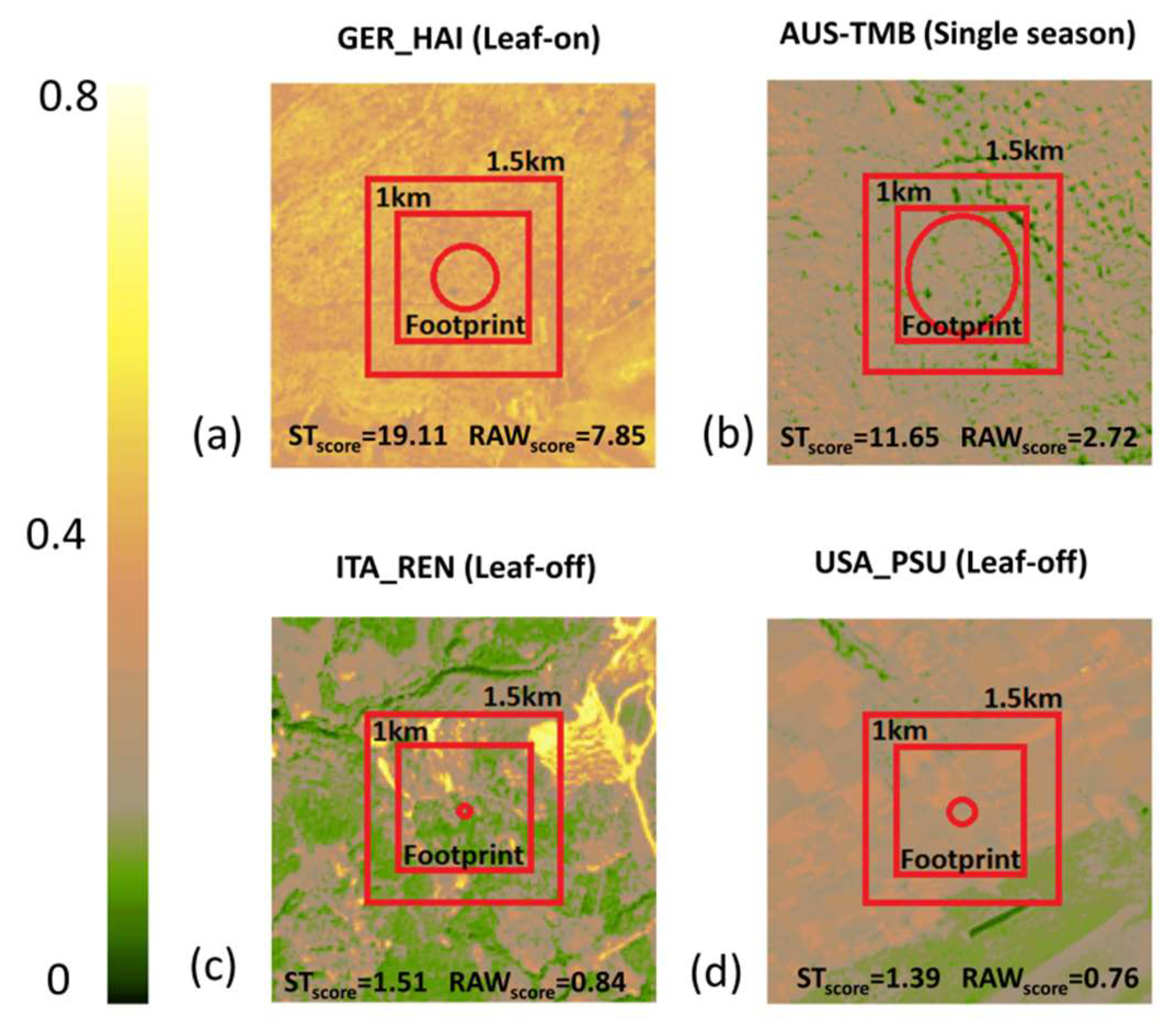
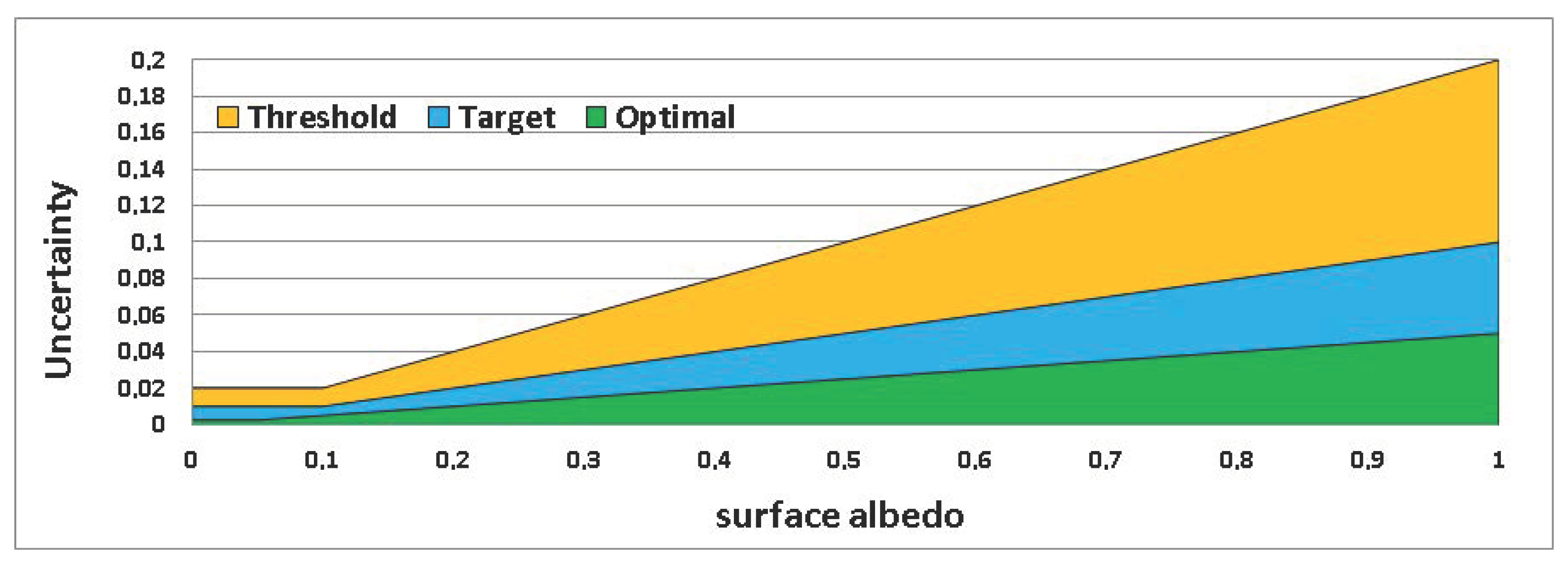
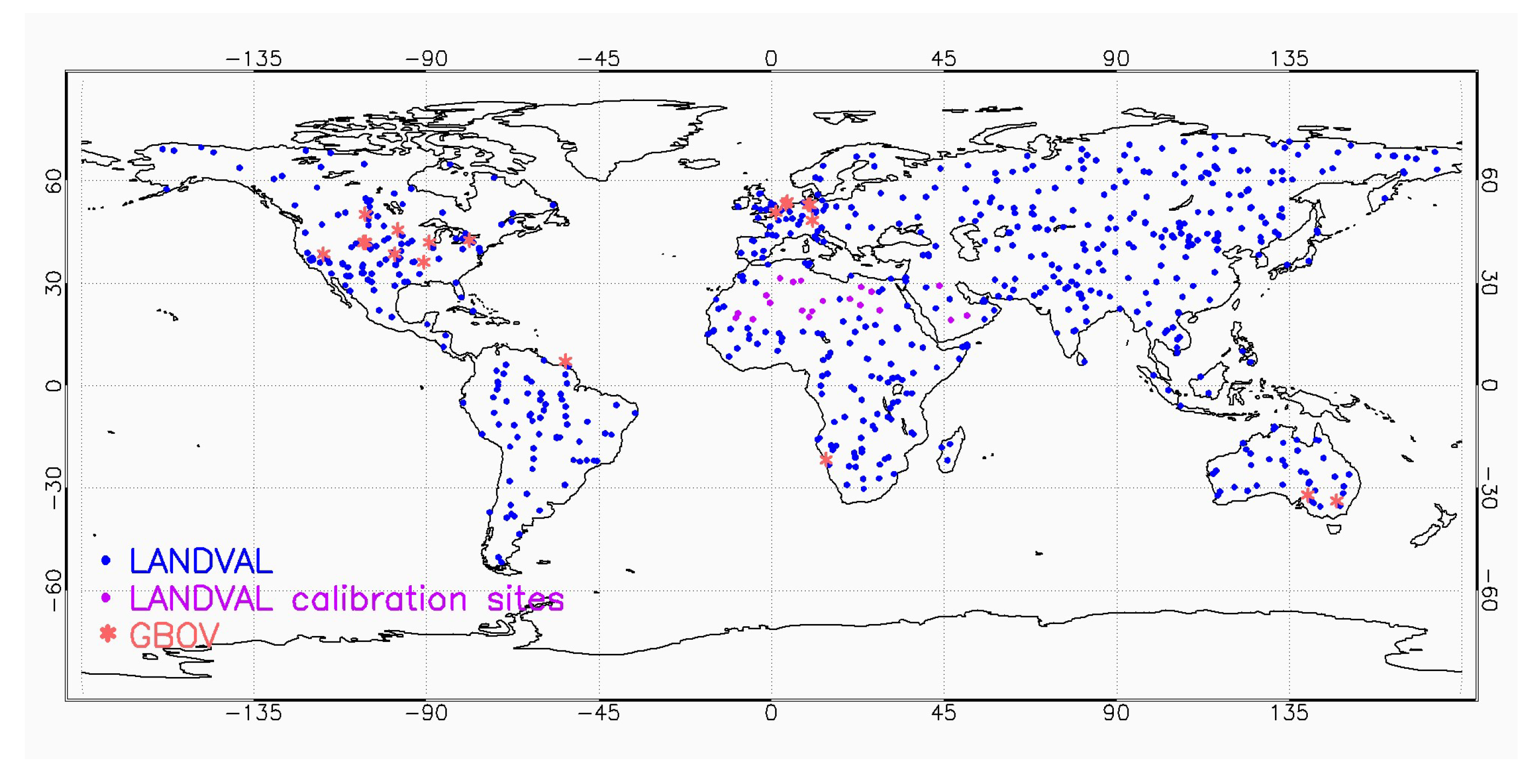


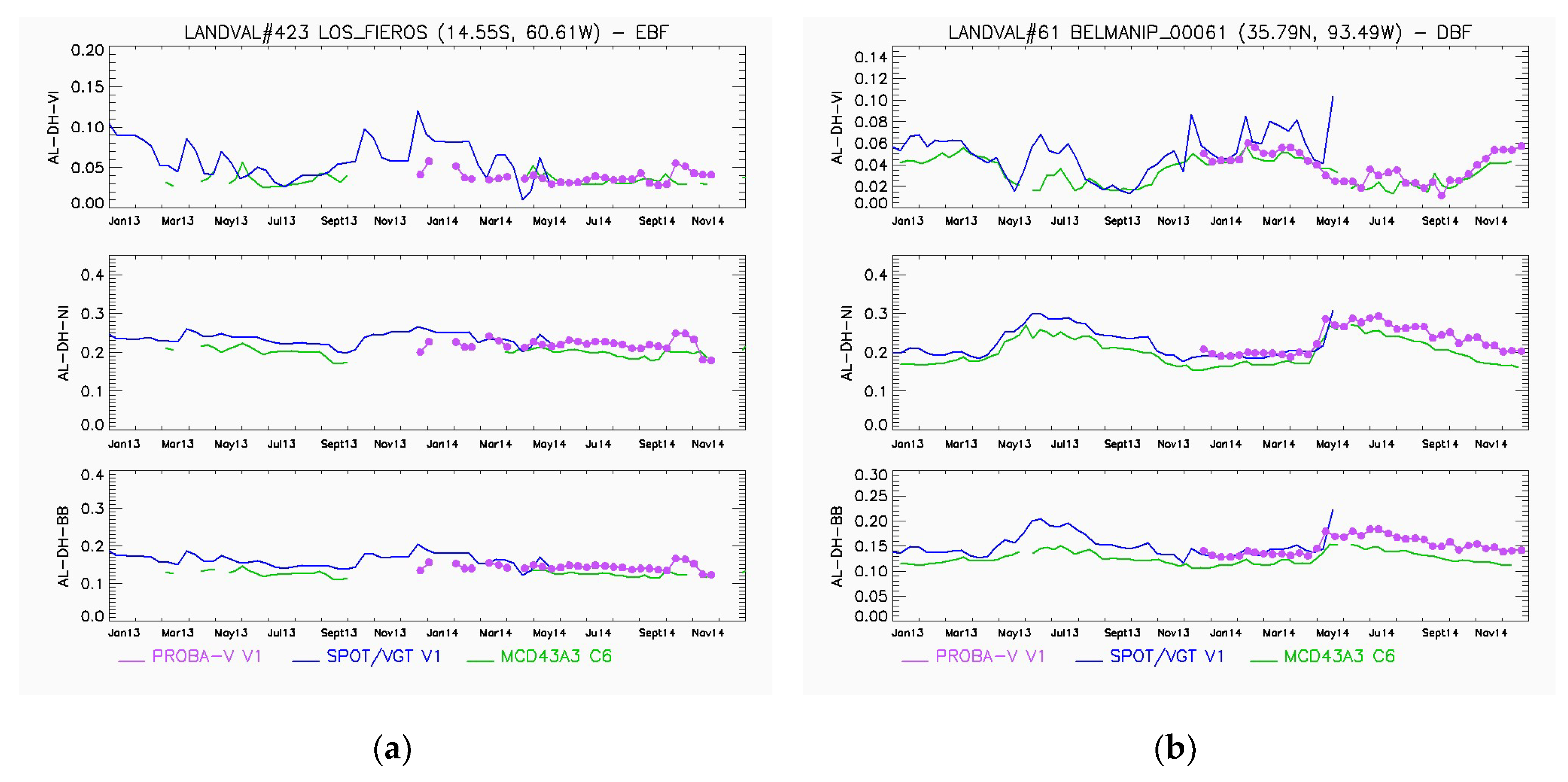
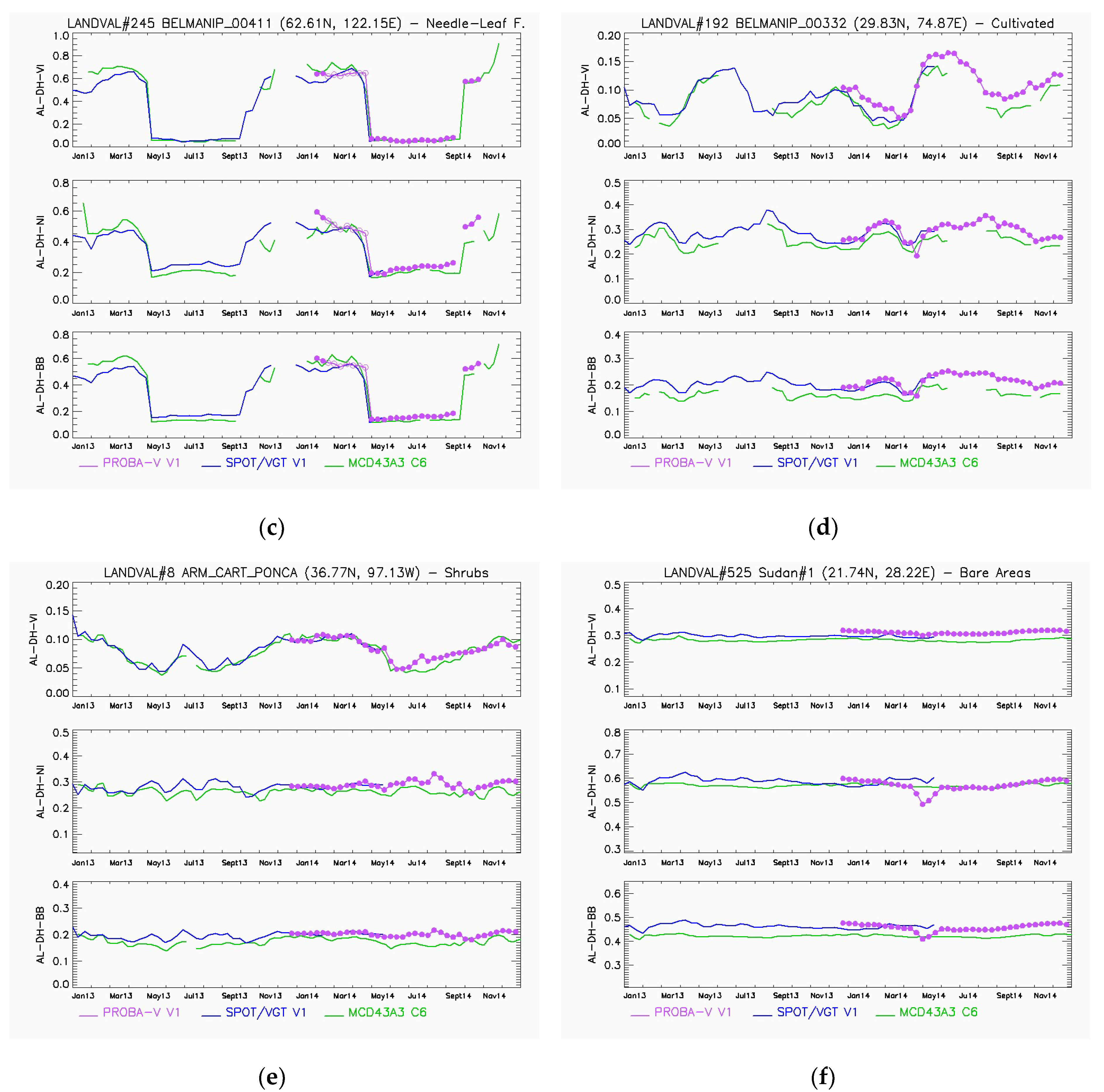
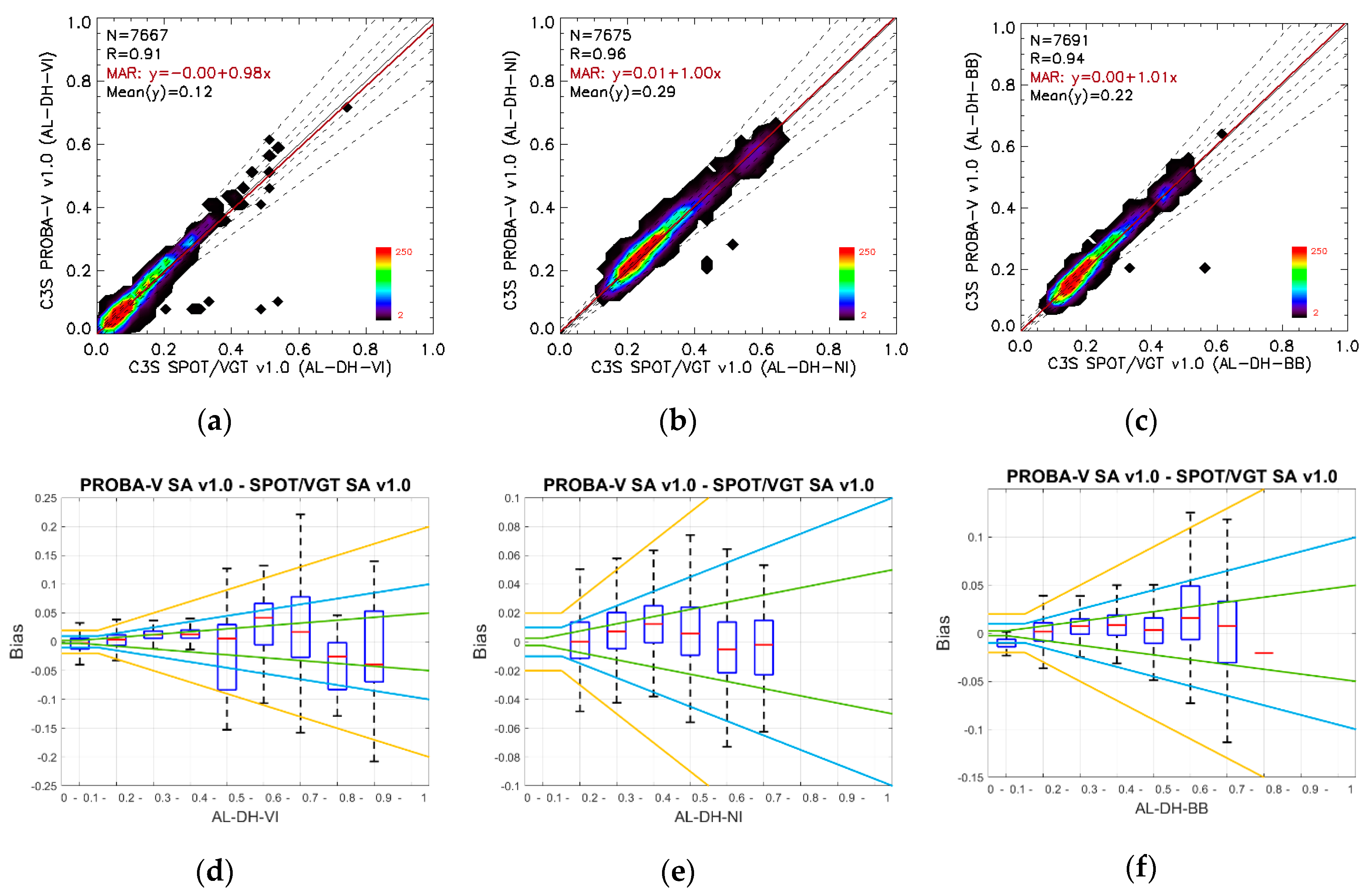
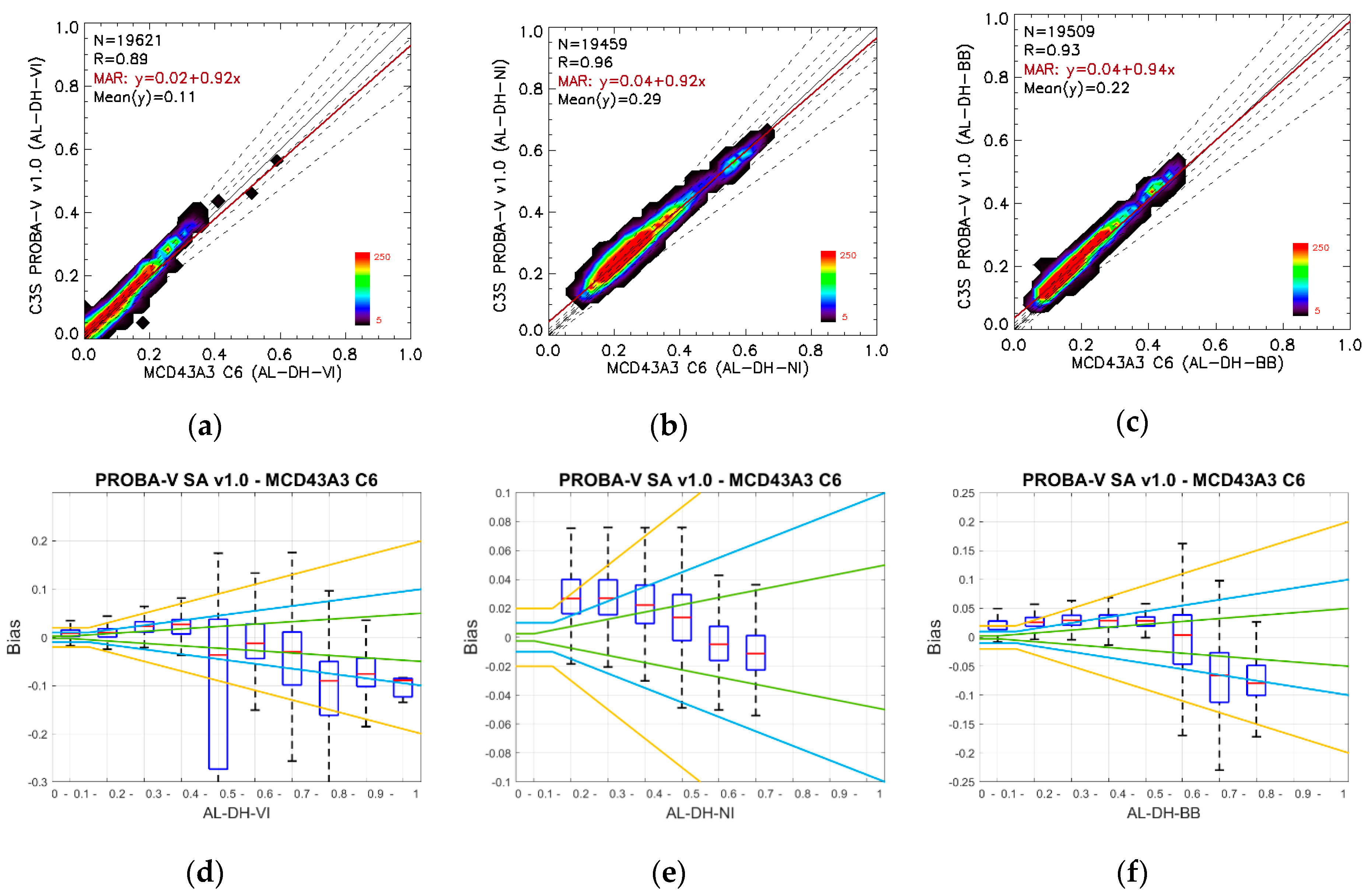

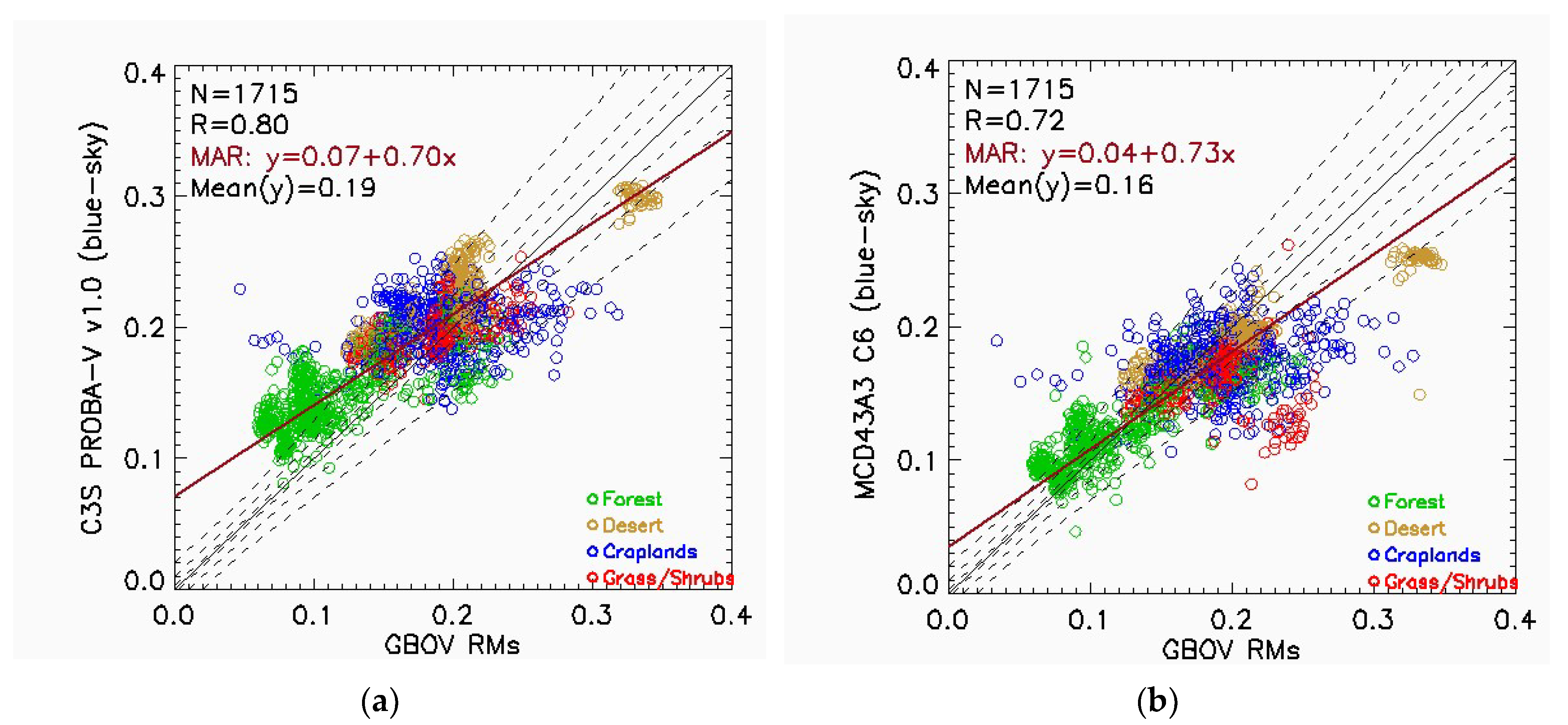
| Product | Satellite /Sensor | BRDF Model: Volumetric /Geometrical Kernels | Frequency /Composite Period | GSD /Projection | Reference |
|---|---|---|---|---|---|
| C3S PROBA-V SA v1.0 | PROBA /VEGETATION | Ross_Thick /Roujean | 10 days /30 days | 1 km /Plate Carrée | [35] |
| C3S SPOT/VGT SA v1.0 | SPOT /VEGETATION | Ross_Thick /Li_Sparse_Reciprocal | 10 days /20 days | 1 km /Plate Carrée | [36] |
| NASA MCD43A3 C6 | TERRA+AQUA /MODIS | Ross_Thick /Li_Sparse_Reciprocal | Daily /16 days | 500 m /Sinusoidal | [37] |
| PROBA-V | VGT-2 | MODIS | |||||||
|---|---|---|---|---|---|---|---|---|---|
| Acronym | Center (nm) | Width (nm) | Acronym | Center (nm) | Width (nm) | Acronym | Center (nm) | Width (nm) | |
| Blue | B0 | 463 | 46 | B0 | 458 | 37 | Band3 | 489 | 20 |
| Red | B2 | 655 | 79 | B2 | 653 | 74 | Band1 | 645 | 50 |
| NIR | B3 | 845 | 144 | B3 | 838 | 109 | Band2 | 858.5 | 35 |
| SWIR | MIR | 1600 | 73 | MIR | 1635 | 101 | Band6 | 1639 | 24 |
| Product | Quality Control Used to Discard Pixels |
|---|---|
| C3S PROBA-V SA v1.0 | Sea (bit 1) Input status out of range or invalid (bit 6) B2 saturated (bit 10) B0 saturated (bit 11) |
| C3S SPOT/VGT SA v1.0 | Sea and continental water (bits 0-1 of QFLAG) Algorithm Failed (bit 6 of QFLAG) ERR > 0.2 AGE > 20 |
| MCD43A2 C6 | BRDF_Albedo_Band_Quality_Band1-7: Magnitude inversion (number of observations lower than 7) |
| # | Site ID | Name | Country | Network | Land Cover | Lat (deg) | Lon (deg) |
|---|---|---|---|---|---|---|---|
| 1 | USA_BND | Bondville | USA | SURFRAD | Croplands | 40.052 | −88.373 |
| 2 | USA_BAO | Boulder | USA | BSRN | Croplands | 40.050 | −105.004 |
| 3 | BEL_BRA | Brasschaat | Belgium | FLUXNET | Mixed Forest | 51.309 | 4.521 |
| 4 | NET_CAB | Cabauw | Netherlands | BSRN | Grasslands | 51.971 | 4.927 |
| 5 | AUS_CLP | Calperum | Australia | FLUXNET | Shrublands | −34.003 | 140.588 |
| 6 | USA_DRA | Desert Rock | USA | SURFRAD | Bare Soil | 36.624 | −116.019 |
| 7 | USA_FPK | Fort Peck | USA | SURFRAD | Grasslands | 48.308 | −105.102 |
| 8 | GER_GEB | Gebesee | Germany | FLUXNET | Croplands | 51.100 | 10.914 |
| 9 | NAM_GOB | Gobabeb | Namibia | BRSN | Bare Soil | −23.561 | 15.042 |
| 10 | USA_GCM | Goodwin Creek | USA | SURFRAD | Decidous Broadleaf | 34.255 | −89.873 |
| 11 | FRA_GRI | Grignon | France | FLUXNET | Croplands | 48.844 | 1.952 |
| 12 | FRA_GUY | Guyaflux | French Guyana | FLUXNET | Evergreen Broadleaf | 5.279 | −52.925 |
| 13 | GER_HAI | Hainich | Germany | FLUXNET | Mixed Forest | 51.070 | 10.450 |
| 14 | USA_NRF | Niwot Ridge | USA | FLUXNET | Evergreen Needelleaf | 40.033 | −105.546 |
| 15 | ITA_REN | Renon | Italy | FLUXNET | Evergreen Needelleaf | 46.587 | 11.434 |
| 16 | USA_PSU | Rock Springs | USA | SURFRAD | Decidous Broadleaf | 40.720 | −77.931 |
| 17 | USA_SFS | Sioux Falls | USA | SURFRAD | Croplands | 43.730 | −96.620 |
| 18 | USA_SGP | Southern Great Plains | USA | FLUXNET | Croplands | 36.606 | −97.489 |
| 19 | USA_TBL | Table Mountain | USA | SURFRAD | Bare soil and Rocks | 40.125 | −105.237 |
| 20 | AUS_TMB | Tumbarumba | Australia | FLUXNET | Evergreen Broadleaf | −35.657 | 148.152 |
| # | Site ID | Footprint (m) | Seasonal Period | RCV (%) | RSE (%) | RST (%) | RSV (%) | STscore | RAWscore |
|---|---|---|---|---|---|---|---|---|---|
| 1 | USA_BND | 126 | Leaf-off | 5.24 | 42.63 | −5.17 | 59.16 | 1.52 | 9.54 |
| Leaf-on | −4.56 | 48.50 | 2.84 | 37.10 | 1.58 | 10.9 | |||
| 2 | USA_BAO | 3788 | Leaf-off | 175.37 | 0.00 | −3.30 | −15.64 | 1.54 | 0.29 |
| Leaf-on | 19.43 | 0.00 | 2.77 | −44.65 | 4.49 | 2.57 | |||
| 3 | BEL_BRA | 505 | Leaf-off | 11.24 | 0.01 | 0.15 | −4.37 | 19.02 | 4.45 |
| Leaf-on | 12.74 | 0.06 | −0.39 | −14.61 | 10.74 | 3.93 | |||
| 4 | NET_CAB | 213 | Leaf-off | 11.31 | 0.00 | −2.61 | 7.13 | 14.25 | 4.42 |
| Leaf-on | 32.62 | 0.00 | 0.74 | 11.70 | 1.66 | 1.53 | |||
| 5 | AUS_CLP | 253 | Leaf-off | −5.83 | 31.92 | 4.15 | −4.62 | 2.72 | 8.58 |
| Leaf-on | −11.07 | 29.70 | 2.53 | −3.13 | 2.83 | 4.52 | |||
| 6 | USA_DRA | 126 | Single season | 18.88 | 23.5 | 6.0 | 83.9 | 1.67 | 2.65 |
| 7 | USA_FPK | 126 | Leaf-off | 7.01 | 19.5 | −2.03 | −1.25 | 4.37 | 7.13 |
| Leaf-on | 42.27 | 23.5 | 3.36 | 69.44 | 1.62 | 1.18 | |||
| 8 | GER_GEB | 76 | Leaf-off | 10.35 | 81.49 | −1.70 | 41.86 | 1.01 | 4.83 |
| Leaf-on | −24.49 | 73.04 | 5.35 | −13.41 | 1.14 | 2.04 | |||
| 9 | NAM_GOB | 10 | Leaf-off | 11.67 | 51.27 | 2.37 | 40.41 | 1.44 | 4.29 |
| Leaf-on | 26.47 | 58.17 | 0.92 | 47.89 | 1.20 | 1.89 | |||
| 10 | USA_GCM | 126 | Leaf-off | −17.17 | 75.3 | 2.94 | 10.00 | 1.17 | 2.91 |
| Leaf-on | 30.21 | 75.2 | −5.02 | 45.76 | 0.98 | 1.65 | |||
| 11 | FRA_GRI | 67 | Leaf-off | 5.30 | 68.84 | −4.99 | 29.89 | 1.22 | 9.44 |
| Leaf-on | 10.62 | 61.83 | 4.17 | 0.42 | 1.49 | 4.71 | |||
| 12 | FRA_GUY | 253 | Single season | −0.72 | 7.85 | 2.47 | −1.98 | 10.45 | 69.33 |
| 13 | GER_HAI | 530 | Leaf-off | 7.66 | 0.00 | 5.94 | 22.01 | 8.43 | 6.53 |
| Leaf-on | −6.37 | 0.00 | 1.94 | 7.40 | 19.11 | 7.85 | |||
| 14 | USA_NRF | 322 | Leaf-off | −19.95 | 7.43 | −12.98 | −10.77 | 4.55 | 2.51 |
| Leaf-on | 6.71 | 6.61 | −7.07 | 3.28 | 8.13 | 7.45 | |||
| 15 | ITA_REN | 12 | Leaf-off | 59.74 | 15.75 | 7.80 | 84.41 | 1.51 | 0.84 |
| Leaf-on | 21.44 | 32.85 | −2.00 | 10.26 | 2.27 | 2.33 | |||
| 16 | USA_PSU | 126 | Leaf-off | 66.21 | 24.94 | 12.73 | 61.96 | 1.39 | 0.76 |
| Leaf-on | 5.06 | 22.86 | 3.16 | −14.45 | 3.29 | 9.89 | |||
| 17 | USA_SFS | 32 | Leaf-off | 7.33 | 75.5 | 1.56 | −6.74 | 1.24 | 6.82 |
| Leaf-on | 21.08 | 49.5 | 7.29 | 104.41 | 1.07 | 2.37 | |||
| 18 | USA_SGP | 152 | Leaf-off | −14.76 | 37.13 | −13.21 | 23.66 | 1.84 | 3.39 |
| Leaf-on | 10.02 | 35.26 | −10.84 | 104.30 | 1.30 | 4.99 | |||
| 19 | USA_TBL | 126 | Leaf-off | 26.68 | 69.72 | −4.78 | 79.70 | 0.94 | 1.87 |
| Leaf-on | −17.46 | 64.91 | 6.59 | −2.34 | 1.36 | 2.86 | |||
| 20 | AUS_TMB | 884 | Single season | 18.41 | 0.00 | 0.06 | 7.27 | 11.65 | 2.72 |
| GCOS | WMO | C3S KPI | |
|---|---|---|---|
| Surface Albedo requirements | Max (5%; 0.0025) | Goal: 5% Breakthrough: 10% Threshold: 20% | Max (10%; 0.01) |
| Optimal | Target | Threshold | |
|---|---|---|---|
| Surface Albedo Uncertainty Requirements | Max [5%, 0.0025] | Max [10%, 0.01] | Max [20%, 0.02] |
| Quantity | Validation Metric |
|---|---|
| Completeness | Gap size distribution (spatial and temporal) Gap length |
| Precision | Median 3-point difference (intra-annual precision) Median absolute deviation (inter-annual precision) |
| Accuracy | Median Error Box-plots of the bias per albedo range |
| Uncertainty | Root mean square deviation (RMSD) Scatter-plots of match-ups (MAR Linear models and correlation) |
| PROBA-V SA v1.0 vs. SPOT/VGT SA v1.0 (Dec 2013–May 2014) | ||||||
|---|---|---|---|---|---|---|
| AL-DH-VI | AL-DH-NI | AL-DH-BB | AL-BH-VI | AL-DH-NI | AL-BH-BB | |
| Median_Err | 0.01 | 0.014 | 0.01 | 0.013 | 0.02 | 0.014 |
| (Median_Err %) | (8%) | (5%) | (4.7%) | (10%) | (6.3%) | (5.9%) |
| Bias | −0.003 | 0.007 | 0.002 | −0.024 | 0.007 | 0.002 |
| (Bias %) | (2.2%) | (2.3%) | (0.9%) | (2.8%) | (2.4%) | (1.0%) |
| RMSD | 0.044 | 0.031 | 0.032 | 0.047 | 0.037 | 0.036 |
| (RMSD %) | (35.3%) | (10.5%) | (14.5%) | (36.1%) | (11.7%) | (15.2%) |
| PROBA-V SA v1.0 vs. MCD43A3 C6 (2014) | ||||||
|---|---|---|---|---|---|---|
| AL-DH-VI | AL-DH-NI | AL-DH-BB | AL-BH-VI | AL-BH-NI | AL-BH-BB | |
| Median_Err | 0.011 | 0.025 | 0.027 | 0.012 | 0.029 | 0.031 |
| (Median_Err %) | (9.8%) | (9%) | (13.4%) | (10.1%) | (9.9%) | (14.5%) |
| Bias | 0.006 | 0.024 | 0.024 | 0.006 | 0.029 | 0.029 |
| (Bias %) | (5.3%) | (8.4%) | (11.9%) | (5.1%) | (9.6%) | (13.3%) |
| RMSD | 0.048 | 0.039 | 0.044 | 0.048 | 0.045 | 0.048 |
| (RMSD %) | (43.3%) | (14%) | (21.5%) | (41.4%) | (15.1%) | (22.2%) |
| PROBA-V SA v1.0 vs. SPOT/VGT SA v1.0 (Dec 2013–May 2014) | ||||||
| AL-DH-VI | AL-DH-NI | AL-DH-BB | AL-BH-VI | AL-BH-NI | AL-BH-BB | |
| % optimal (GCOS) | 28.9 | 48.6 | 50.2 | 23.9 | 39.9 | 41.8 |
| % target (C3S KPI) | 62.9 | 76.8 | 78.5 | 51.3 | 68.5 | 69.9 |
| % threshold | 83.1 | 92.6 | 88.1 | 72.8 | 90.2 | 82.6 |
| PROBA-V SA v1.0 vs. MCD43A3 C6 (2014 year) | ||||||
| AL-DH-VI | AL-DH-NI | AL-DH-BB | AL-BH-VI | AL-BH-NI | AL-BH-BB | |
| % optimal (GCOS) | 20.4 | 24.5 | 6.5 | 20.9 | 22.9 | 6.7 |
| % target (C3S KPI) | 55.5 | 50.4 | 24.8 | 52.7 | 46.4 | 23 |
| % threshold | 83.5 | 78.7 | 50.7 | 80.5 | 77.4 | 49.8 |
| Median of 3-Point Difference (i.e., Median δ Values) | ||||||
|---|---|---|---|---|---|---|
| AL-DH-VI | AL-DH-NI | AL-DH-BB | AL-BH-VI | AL-BH-NI | AL-BH-BB | |
| PROBA-V SA v1.0 | 0.0026 | 0.0052 | 0.0035 | 0.0039 | 0.0074 | 0.0050 |
| SPOT/VGT SA v1.0 | 0.0042 | 0.0047 | 0.0041 | 0.0057 | 0.0063 | 0.0055 |
| MCD43A3 C6 | 0.0012 | 0.0022 | 0.0016 | 0.0018 | 0.0032 | 0.0023 |
| Inter-Annual Precision (Median Absolute Deviation) | ||||||
|---|---|---|---|---|---|---|
| AL-DH-VI | AL-DH-NI | AL-DH-BB | AL-BH-VI | AL-BH-NI | AL-BH-BB | |
| PROBA-V SA v1.0 | 0.004 (1.2%) | 0.006 (1.1%) | 0.004 (0.9%) | 0.004 (1.3%) | 0.008 (1.3%) | 0.006 (1.2%) |
| SPOT/VGT SA v1.0 | 0.008 (2.6%) | 0.012 (2%) | 0.009 (2%) | 0.011 (3.7%) | 0.02 (3.3%) | 0.014 (3%) |
| MCD43A3 C6 | 0.003 (0.9%) | 0.005 (0.8%) | 0.004 (0.8%) | 0.003 (1.2%) | 0.006 (1.1%) | 0.005 (1.1%) |
| PROBA-V SA v1.0 | MCD43A3 C6 | |
|---|---|---|
| Median Error (Median Error %) | 0.032 (18.2%) | 0.018 (11.2%) |
| Bias (Bias %) | 0.020 (11.5%) | −0.010 (5.9%) |
| RMSD (RMSD %) | 0.04 (22.4%) | 0.04 (24.8%) |
| PROBA-V SA v1.0 | MCD43A3 C6 | |
|---|---|---|
| % optimal (GCOS) | 15.5 | 23.7 |
| % target (C3S KPI) | 28.6 | 45.5 |
| % threshold | 44.2 | 58.0 |
| PROBA-V SA v1.0 vs. GBOV RM | ||||
|---|---|---|---|---|
| Forest | Crops | Grass/Shrubs | Desert | |
| Number of Samples (stations) | 608 (8) | 488 (6) | 316 (3) | 303 (3) |
| Median Error (Median Error %) | 0.037 (27.0%) | 0.036 (18.3%) | 0.015 (7.8%) | 0.037 (16.7%) |
| Bias (Bias %) | 0.030 (22.4%) | 0.014 (7.4%) | 0.008 (4.2%) | 0.023 (10.4%) |
| RMSD (RMSD %) | 0.044 (32.6%) | 0.044 (22.4%) | 0.024 (12.2%) | 0.038 (17.2%) |
| % optimal (GCOS) | 6.1 | 12.4 | 38.9 | 15.5 |
| % target (C3S KPI) | 13.8 | 25.8 | 59.5 | 30.4 |
| % threshold | 22.9 | 38.7 | 75.3 | 63.4 |
| MCD43A3 C6 vs. GBOV RM | ||||
|---|---|---|---|---|
| Forest | Crops | Grass/Shrubs | Desert | |
| Number of Samples (stations) | 608 (8) | 488 (6) | 316 (3) | 303 (3) |
| Median Error (Median Error %) | 0.015 (12.1%) | 0.021 (11.3%) | 0.020 (11.5%) | 0.017 (8.4%) |
| Bias (Bias %) | 0.003 (2.8%) | −0.012 (6.7%) | −0.027 (15.3%) | −0.013 (6.5%) |
| RMSD (RMSD %) | 0.031 (25.2%) | 0.051 (28.0%) | 0.042 (24.1%) | 0.036 (17.8%) |
| % optimal (GCOS) | 21.5 | 25.4 | 18.4 | 30.7 |
| % target (C3S KPI) | 41.1 | 44.5 | 43.4 | 58.1 |
| % threshold | 58.9 | 53.5 | 52.8 | 68.6 |
© 2020 by the authors. Licensee MDPI, Basel, Switzerland. This article is an open access article distributed under the terms and conditions of the Creative Commons Attribution (CC BY) license (http://creativecommons.org/licenses/by/4.0/).
Share and Cite
Sánchez-Zapero, J.; Camacho, F.; Martínez-Sánchez, E.; Lacaze, R.; Carrer, D.; Pinault, F.; Benhadj, I.; Muñoz-Sabater, J. Quality Assessment of PROBA-V Surface Albedo V1 for the Continuity of the Copernicus Climate Change Service. Remote Sens. 2020, 12, 2596. https://doi.org/10.3390/rs12162596
Sánchez-Zapero J, Camacho F, Martínez-Sánchez E, Lacaze R, Carrer D, Pinault F, Benhadj I, Muñoz-Sabater J. Quality Assessment of PROBA-V Surface Albedo V1 for the Continuity of the Copernicus Climate Change Service. Remote Sensing. 2020; 12(16):2596. https://doi.org/10.3390/rs12162596
Chicago/Turabian StyleSánchez-Zapero, Jorge, Fernando Camacho, Enrique Martínez-Sánchez, Roselyne Lacaze, Dominique Carrer, Florian Pinault, Iskander Benhadj, and Joaquín Muñoz-Sabater. 2020. "Quality Assessment of PROBA-V Surface Albedo V1 for the Continuity of the Copernicus Climate Change Service" Remote Sensing 12, no. 16: 2596. https://doi.org/10.3390/rs12162596
APA StyleSánchez-Zapero, J., Camacho, F., Martínez-Sánchez, E., Lacaze, R., Carrer, D., Pinault, F., Benhadj, I., & Muñoz-Sabater, J. (2020). Quality Assessment of PROBA-V Surface Albedo V1 for the Continuity of the Copernicus Climate Change Service. Remote Sensing, 12(16), 2596. https://doi.org/10.3390/rs12162596








